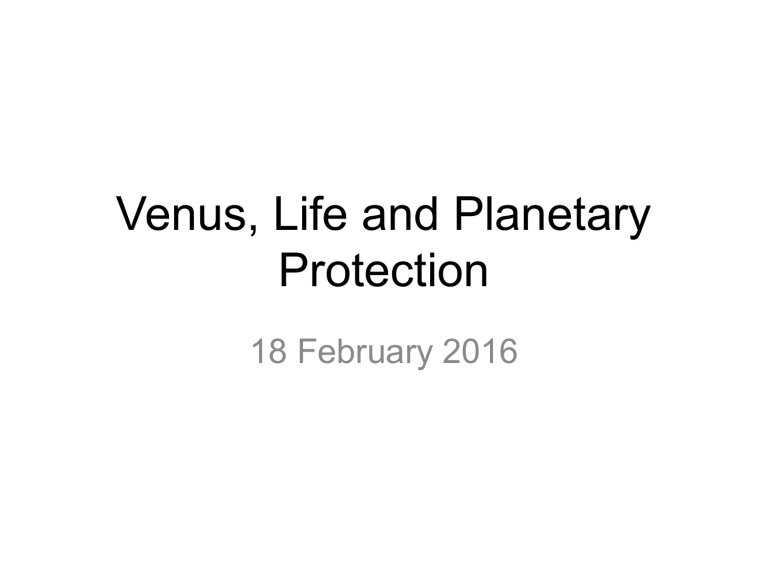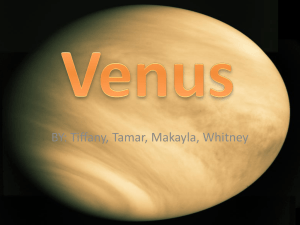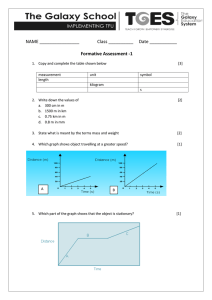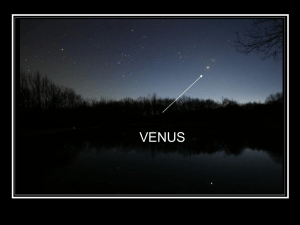Venus, Life and Planetary Protection 18 February 2016

Venus, Life and Planetary
Protection
18 February 2016
Mars
Mercury
Terrestrial
Planets
Venus
Earth
Moon
Hubble observes
Venus
Life is definitely possible in this atmosphere
But it is too hot at the surface!
Venus - Isolated continents, extensive volcanic plains.
• Plate tectonics? No. Explains Earth geology, but not Venus.
• Resurfaced ~600 million years ago
Volcanic
Resurfacing of
Venus
7000 km long lava river - Baltis Vallis longest river in the solar system
Extensive cracking from:
• loading by mass of lava
• shrinking on cooling
• stresses from underlying convection
Stresses from underlying plume pushing up crust from below
Arachnoid crater
Tick crater
Lava flows
Pancake domes
It does not look good for life: Too hot, poisonous gases
Search for Life on Venus?
• Putting Earth habitability in context: Venus is like
Earth’s ‘twin’
• The possibility of extinct or extant life.
• The future of life on Earth.
• Planetary protection issues?
Putting Earth ’ s Habitability in Context
• Who kept its ocean longer, Venus or Mars? How was the habitable real estate distributed in the inner solar system?
• Understanding the longevity of oceans , and the range of physical parameters which facilitates plate tectonics, is key to defining stellar habitable zones.
• Further exploration of Venus will greatly advance this cause, and provide needed context for extrasolar terrestrial planet discoveries.
History of Venus: A Unified Scenario
• ≈ 2 Gy Loss of surface water, subduction of hydrated sediments ceases.
• Lack of water makes lithosphere thicker & more difficult to break.
• Crustal recycling is inhibited: Carbon cycle does not provide a thermostat
• ≈ 1 Gy Plate tectonics ceases, Venus becomes a “ 1 plate planet ”
• 700 My to present: localized volcanism and tectonism
Venus may have been a habitable planet (with an oxygenated atmosphere) for much of Solar System history.
The Possibility of Extant Life
• Longevity of oceans remains highly uncertain. During an extended period of water loss, Venus probably enjoyed an oxygenated atmosphere.
• When young, the terrestrial planets were constantly exchanging material by impacts
• Favorable environmental conditions for origin or transplantation of life.
• As surface conditions became hostile, life could have adapted to an atmospheric niche under directional selection.
The Future of Life on Earth
• In about 1 Gy, the Earth may experience a runaway
H
2
O greenhouse.
Planetary Protection Objectives
• Don’t confuse evidence for life with organisms brought from Earth
• Don’t pollute other planets with invasive Earth organisms
• Protect the Earth from life from other planets
Issues
• Can life survive on the target body?
• Might life have arisen there?
• Will the spacecraft land or just fly by?
• Will samples be returned to Earth?
• ‘Forward’ or ‘Back’ contamination?
• How to reduce the risk: we can’t be 100% certain…
How to protect
• Sterilize spacecraft to reduce bioload: One sneeze contains a million microbes
• Don’t hit a possible life abode by chance
• Park the spacecraft in a high orbit
• Crash into some lifeless world or deadly location at mission end
• Quarantine samples returned to Earth
Summary
• Venus is a world like Earth, gone terribly bad from a greenhouse effect
• The planets were more similar when life arose on Earth: Venus likely had an ocean
• Early Venus life might still survive floating in the Venus clouds
• We must be responsible to not contaminate other worlds (UN treaty 1967)






